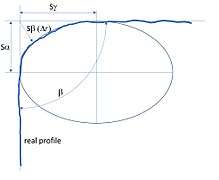Cutting tool (machining)
In the context of machining, a cutting tool or cutter is any tool that is used to remove some material from the work piece by means of shear deformation. Cutting may be accomplished by single-point or multipoint tools. Single-point tools are used in turning, shaping, planing and similar operations, and remove material by means of one cutting edge. Milling and drilling tools are often multipoint tools. It is a body having teeth or cutting edges on it. Grinding tools are also multipoint tools.[1] Each grain of abrasive functions as a microscopic single-point cutting edge (although of high negative rake angle), and shears a tiny chip.
Cutting tool materials must be harder than the material which is to be cut, and the tool must be able to withstand the heat and force generated in the metal-cutting process. Also, the tool must have a specific geometry, with clearance angles designed so that the cutting edge can contact the workpiece without the rest of the tool dragging on the workpiece surface. The angle of the cutting face is also important, as is the flute width, number of flutes or teeth, and margin size. In order to have a long working life, all of the above must be optimized, plus the speeds and feeds at which the tool is run.
Types
Linear cutting tools include tool bits (single-point cutting tools) and broaches. Rotary cutting tools include drill bits, countersinks and counterbores, taps and dies, milling cutters, reamers, and cold saw blades. Other cutting tools, such as bandsaw blades, hacksaw blades, and fly cutters, combine aspects of linear and rotary motion
Cutting tools with inserts (indexable tools)
Cutting tools are often designed with inserts or replaceable tips (tipped tools). In these, the cutting edge consists of a separate piece of material, either brazed, welded or clamped on to the tool body. Common materials for tips include cemented carbide, polycrystalline diamond, and cubic boron nitride.[2] Tools using inserts include milling cutters (endmills, fly cutters), tool bits, and saw blades.
Holder
Tool setup
The detailed instruction how to combine the tool assembly out of basic holder, tool and insert can be stored in a tool management solution.
Cutting edge
The cutting edge of a cutting tool is a very important for the performance of the cutting process. The main features of the cutting edge are:
- form of the cutting edge: radius or waterfall or trumpet.
- cutting edge angles (free angle and rake angle)
- form and size of the chamfers
The measurement of the cutting edge is performed using a tactile instrument or an instrument using focus variation. To quantify a cutting edge the following parameters are used:
- cutting edge radius for symmetric edges
- cutting edge ellipse axis for asymmetric edges.
- factor K, this is the relation between Sγ and Sα. This can also be calculated by the ratio of the two axis of the ellipse. This factor describes the form of the cutting edge.
- 3 angles: clearance angle, wedge angle, rake (chipping) angle
- Δr
- length and orientation of the bevel

One of the most important cutting edge parameters is the K factor. It specify the form of the cutting edge. 1 means a symmetric cutting edge. If the value is smaller the form is called a waterfall. If the value is larger than 1 it is called a trompete. Depending on the cutting material, feed rate and other influence factors a cutting tool with the optimum K factor should be used.
References
- Explain Cutting Tools Archived 2019-05-12 at the Wayback Machine, https://mechanicalsite.com, retrieved 2019-05-12.
- Stephenson, David A.; Agapiou, John S. (1997), Metal cutting theory and practice, Marcel Dekker, p. 164, ISBN 978-0-8247-9579-5.